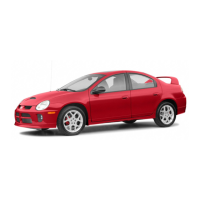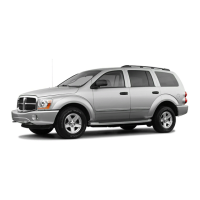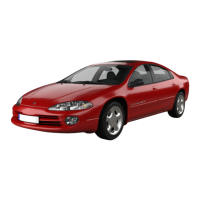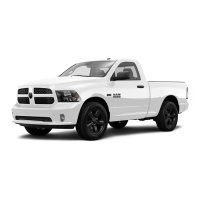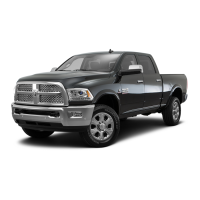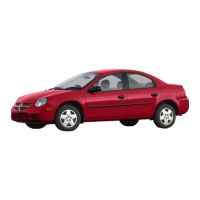> 3rd gear PEMCC from 43-50 Km/h (27-31
MPH)
> DTC P0218 is set
Super Overheat: Oil temperature above 135°C
(275°F) or Engine coolant temperature above 124°C
(255°F)
> Goes back to Overheat below 124°C (255°F) oil
temperature
> AutoStick feature is disabled
> DTC P1797 is set
Causes for operation in the wrong tempera-
ture shift schedule: Extreme Cold or Cold shift
schedule at start up:
> Temperature Sensor circuit.
> Overheat or Super Overheat shift schedule
after extended operation:
> Operation in city traffic or stop and go traffic
> Engine idle speed too high
> Aggressive driving in low gear
> Trailer towing in OD gear position (use 3
position (or A/S 3rd) if frequent shifting oc-
curs)
> Cooling system failure causing engine to op-
erate over 110°C (230°F)
> Engine coolant temperature stays low too long
- If engine coolant temperature drops below
65°C (150°F), the transmission will disengage
EMCC. Extended operation with the EMCC
disengaged will cause the transmission to
overheat.
> Brake switch issue will cause the EMCC to
disengage. Extended oepration with the
EMCC disengaged will cause the transmis-
sion to overheat.
> Tranmission fluid overfilled
> Transmission cooler or cooler lines restricted
> Transmission Temperature Sensor circuit
3.3 DIAGNOSTIC TROUBLE CODES
Diagnostic trouble codes (DTC’s) are codes stored
by the Powertrain Control Module (PCM) that help
us diagnose Transmission problems. They are
viewed using the DRBIIIt scan tool.
Always begin by performing a visual inspection of
the wiring, connectors, cooler lines and the trans-
mission. Any obvious wiring problems or leaks
should be repaired prior to performing any diagnos-
tic test procedures. Some engine driveability prob-
lems can be misinterpreted as a transmission prob-
lem. Ensure that the engine is running properly
and no engine DTC’s are present that could cause a
transmission complaint.
If there is a communication bus problem, trouble
codes will not be accessible until the problem is
fixed. The DRBIIIt will display an appropriate
message. The following is a possible list of causes
for a bus problem:
– open or short to ground/battery in PCI bus
circuit.
– internal failure of any module or component on
the bus
Each diagnostic trouble code is diagnosed by
following a specific testing sequence. The diagnostic
test procedures contain step-by-step instructions
for determining the cause of a transmission diag-
nostic trouble code. Possible sources of the code are
checked and eliminated one by one. It is not neces-
sary to perform all of the tests in this book to
diagnose an individual code. These tests are based
on the problem being present at the time that the
test is run.
All testing should be done with a fully charged
battery.
If the PCM records a DTC that will adversely
affect vehicle emissions, it will request (via the
communication bus) that the PCM illuminate the
Malfunction Indicator Lamp (MIL). Although these
DTC’s will be stored in the PCM immediately as a 1
trip failure, it may take up to five minutes of
accumulated trouble confirmation to set the DTC
and illuminate the MIL. Three consecutive success-
ful OBDII (EURO STAGE III OBD) trips or clearing
the DTC’s with a diagnostic tool (DRBIIIt or equiv-
alent) is required to extinguish the MIL. When the
Transmission Control system requests that the
PCM illuminate the MIL, the PCM sets a DTC
P0700 ($89) to alert the technician that there are
DTC’s in the Transmission Control System. This
must also be erased in the PCM in order to extin-
guish the MIL.
3.3.1 HARD CODE
Any Diagnostic Trouble Code (DTC) that is set
whenever the system or component is monitored is
a HARD code. This means that the problem is there
every time the Transmission Control System checks
that system or component. Some codes will set
immediately at start up and others will require a
road test under specific conditions. It must be
determined if a code is repeatable (Hard) or inter-
mittent before attempting diagnosis.
3.3.2 ONE TRIP FAILURES
A One Trip Failure, when read from the Trans-
mission Control System, is a hard OBDII (EURO
STAGE III OBD) code that has not matured for the
full 5 minutes to a hard fault. This applies to codes
that will only set after 5 minutes of substituted gear
operation.
3
GENERAL INFORMATION
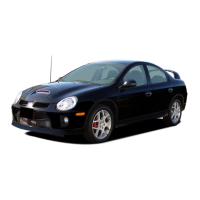
